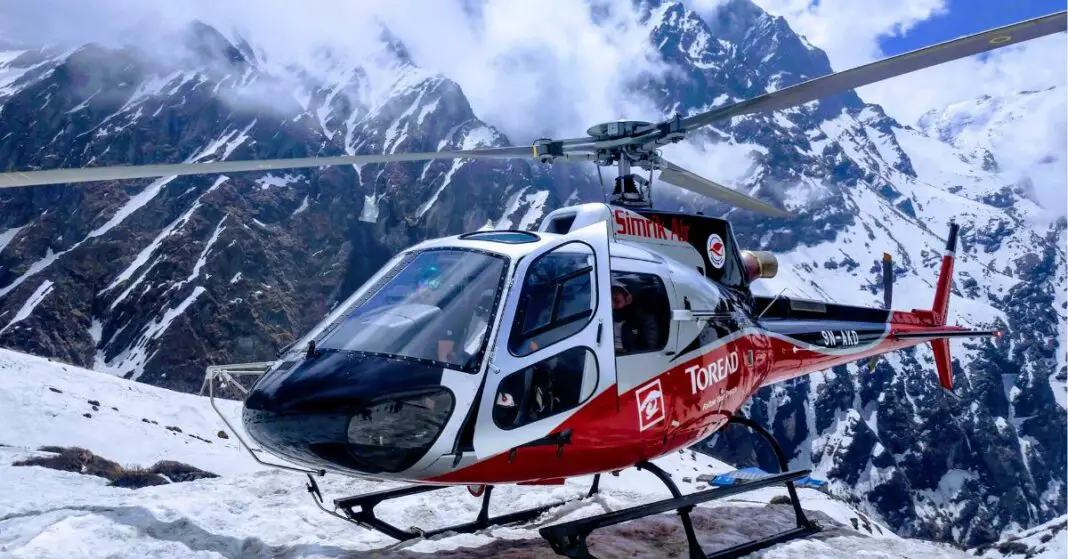Ever wondered about the marvels and perils of rotary-wing flight in the world’s highest altitudes, specifically over Mount Everest? This topic is one replete with intriguing challenges, historical precedents, technological feats, and ecological concerns.
However, mankind’s adventurous spirit, buttressed by rapid advancements in technology, has conquered such testing territories. This article paints a panoramic view of the encounters and understandings of flying helicopters over Mount Everest, offering you insights into an extraordinary segment of aviation history.
Table of Contents
Can helicopters fly to the top of Everest?
In 2005, a French pilot, Didier Delsalle, landed a helicopter on Mount Everest’s summit. This was a big achievement, but it was tough because of the small space and strong winds. The landing only lasted 47 seconds.
After Delsalle’s success, no one else has landed a helicopter on the summit. Regular helicopter trips to the top are risky and impractical. Most helicopters used near Everest can’t fly as high, and the thin air at the summit makes it dangerous.
So, while a helicopter reached Everest’s top once, it’s not something that can be done often. The challenges and dangers make routine helicopter trips to the summit impossible right now.
Watch the following video: On May 14th, 2005 at 7.08 AM (local time), a serial Ecureuil/AStar AS350B3 piloted by the Airbus Helicopters X-test pilot Didier Delsalle, landed at 8,850 meters (29,035ft) on the top of the Mount Everest (Kingdom of Nepal). It was also a world altitude takeoff record.
Can you be rescued by helicopter on Everest?
Though helicopters can’t land directly on the summit of Mount Everest due to the extreme altitude and lack of suitable space, they can be used for rescues with certain limitations. Here’s a summary:
Reaching You:
- Specially designed high-altitude helicopters can fly above Everest’s summit.
- Landing is very hard and risky due to reduced engine power and lift from thin air.
- Rescues involve hovering at a safe distance and using a winch or longline to lift the affected climber into the helicopter.
Factors Affecting Rescue:
- Weather conditions like strong winds and low visibility can hinder helicopter operations.
- Location matters; rescues are more successful at lower points on the mountain.
- The climber’s condition is crucial; severe injuries may make a winch rescue impossible.
Alternatives to Helicopter Rescue:
- Ground evacuation with Sherpas or other climbers is often a safer option at lower altitudes.
- Fixed-wing aircraft might land at lower points or nearby valleys for an alternative evacuation.
In conclusion, while helicopter rescue is a valuable option on Mount Everest, it’s not always possible or guaranteed. Climbers should be aware of limitations, risks, and prioritize avoiding the need for rescue if possible.
The Challenges of Altitude
In such a technologically advanced world, can there exist an environment capable of challenging modern aviation design? The answer lies in the mystifying heights of high-altitude landscapes, specifically its effect on rotary-wing aviation or, more commonly, helicopters.
How do helicopters, known for their remarkable capability for vertical lift-off, precision landing, and hovering, grapple with the harsh realities of high-altitude operations? The answer, as you will find, is intricately linked with physics, engineering, and atmospheric science.
Firstly, it is imperative to understand this simple physics principle: as altitude increases, the air’s density decreases — a phenomenon named “density altitude”. Recalling that a helicopter’s lift relies heavily on air density, high-altitude flight significantly hampers lift generation.
For the rotor blades to “bite” into the air and generate necessary lift, they must compensate for this lower air density by spinning faster or adopting a greater pitch angle, highlighting the first main crux of high-altitude helicopter operations.
Secondly, high altitudes compel rotary-wing aircraft to contend with a particular challenge: decreased engine performance. Just as rotor blades demand dense air to generate lift, combustion in engines requires sufficient oxygen. This scarcity of oxygen at high altitudes results in decreased engine output and, consequentially, less power available for the actuators, further aggravating the issues raised by density altitude.
This leads us to the third point of concern: temperature flux. The realm of high altitudes is notoriously unpredictable and can swing between extreme heat and extreme cold within a matter of hours. Such significant temperature shifts affect equipment functionality, ranging from reduced battery efficiency to augmented fuel viscosity, hence introducing another significant challenge for these rotary aircraft.
Lastly, the hazardous weather conditions prevalent in high-altitude operations pose an often underrated risk. From violent winds capable of destabilizing flight patterns to sudden cloud formation leading to poor visibility, high altitudes encompass a range of potentially perilous weather anomalies.
Ascending Everest: A Historical Overview
Helicopters embarking on the ambitious venture of soaring over the world’s towering apex, Mount Everest, have navigated treacherous terrains and unforgiving climatic conditions throughout history. The mountain’s staggering elevation of 29,031 feet (8,848 meters) poses formidable challenges that continue to push the boundaries of aviation achievements and technological advancements.
Historically, the early 20th century recorded the first helicopter attempts to conquer Everest, revealing critical complications. One such complexity is the substantial drop in atmospheric pressure with increasing altitude. The thin air renders helicopters’ blades less effective in generating lift, a phenomenon known as loss of rotor efficiency, posing significant risks to flight stability.
Furthermore, helicopters, especially those with combustion-based engines, experience fuel consumption issues due to oxygen scarcity. As a rule, these engines depend heavily on sufficient oxygen to combust fuel and generate power. In the oxygen-poor environment of high altitudes, engine capacity plummets, drastically reducing a helicopter’s speed and range.
Volatility in temperature is another aspect that greatly affects the functionality of helicopters. Unlike airplane engines, a helicopter’s engine will not restart if it fails at a certain height. What follows is a life-threatening condition: the helicopter drops like a stone, without the lift generated by the forward motion characteristic of fixed-wing aircraft.
Adverse weather conditions, such as unexpected gusts, frequent storms, blizzards, and potential whiteouts, also amplify the risks. Flying among icy precipices and unpredictable jet streams of the ‘Death Zone’ – areas above 8,000m – can disable electronic systems and ice up rotor blades. These extreme conditions demand purpose-engineered technologies and highly skilled pilots to maintain stable control.
In light of these complexities, attempts over the century have leveraged innovative design and technology to scale Everest successfully. Pioneers such as French aviator Didier Delsalle touched the summit in a modified Eurocopter AS350 B3 in 2005, highlighting the potential of well-adapted designs and exhaustive pilot training. This remarkable accomplishment employed particular modifications like a stripped-down fuselage for weight reduction, a high-limit rotor system, and an optimized turbine for maximum performance at high altitudes.
Moreover, comprehensive training is crucial for pilots embarking on such ambitious endeavors. Mastery of understanding readings from the altimeter, power management in thin air, and thorough knowledge of emergency procedures are paramount. The training combines theoretical knowledge with rigorous practice to ensure rapid, pertinent decision-making in extreme aerial scenarios.
Rotary-Wing Technology and Everest
Overcoming the challenges presented by the formidable height of Mount Everest has not only been the ambition of mountaineers but has also been a captivating goal of the aviation industry, specifically in the realm of helicopter engineering. Advances in technology have continually pushed the envelope of what is possible, with high-altitude flight being a significant waypoint in this quest for exploration and innovation.
Concerning enhancing rotor blade aerodynamics, recent innovations offer robust solutions to previously insurmountable challenges. Traditional rotor blade designs inefficaciously interact with the thin air pressure at high altitudes, drastically reducing lift.
In response, advancements in blade design now make use of materials that offer superior flex and adaptive performance characteristics. This allows helicopters to generate sufficient lift in low-density altitudes, thereby increasing high-altitude performance potentially enough to tackle the daunting Everest.
Also, the pressing issue of assuring optimal engine output at high altitudes has seen contemporary strides. Revolutionary developments have elevated the functionality of engines including twin-turbine engines and intercoolers. These adjust to variations in air density, maintaining consistent and reliable performance, a vital necessity when reaching for the skies.
Furthermore, advancements in fuel technology have contributed to the pursuit of overcoming Everest. The scarcity of oxygen at high altitudes accelerates fuel consumption, thus limiting flight duration. In response, the development of high-efficiency fuel systems has resulted in increased flight longevity. This, combined with advancements in lightweight, high-capacity fuel storage solutions, could enable a helicopter to scale and descend Everest within one flight.
Additionally, innovative avionics have fortified the capabilities of pilots and their helicopters alike. Pilots can now enjoy access to real-time weather updates, 3D terrain mapping, and state-of-the-art navigation systems. These technologies assist pilots in their challenging tasks by reducing uncertainties and improving decision-making, a key aspect in overcoming the high-altitude perils of Everest.
Equally important is the advance in flight suits and survival gear technology, which play a pivotal role in safeguarding the well-being of pilots and passengers in high-altitude missions. The advent of pressurized suits comparable in function to those donned by astronauts offers protection against the thin, airless environment encountered near Everest’s summit. Moreover, heated suits and enhanced oxygen kits ensure thermal and respiratory support, crucial for survival in Everest’s extreme conditions.
On the whole, the continual evolution of helicopter technology to meet and overcome the Everest challenge is a testament to the perseverance and ingenuity of aircraft engineers and pilots alike. As aptly put by eminent aerospace engineer Theodore Von Karman, “Scientists study the world as it is; engineers create the world that has never been.”
Also Read:
Are Helicopters safer than planes?
Can you land a helicopter anywhere?





